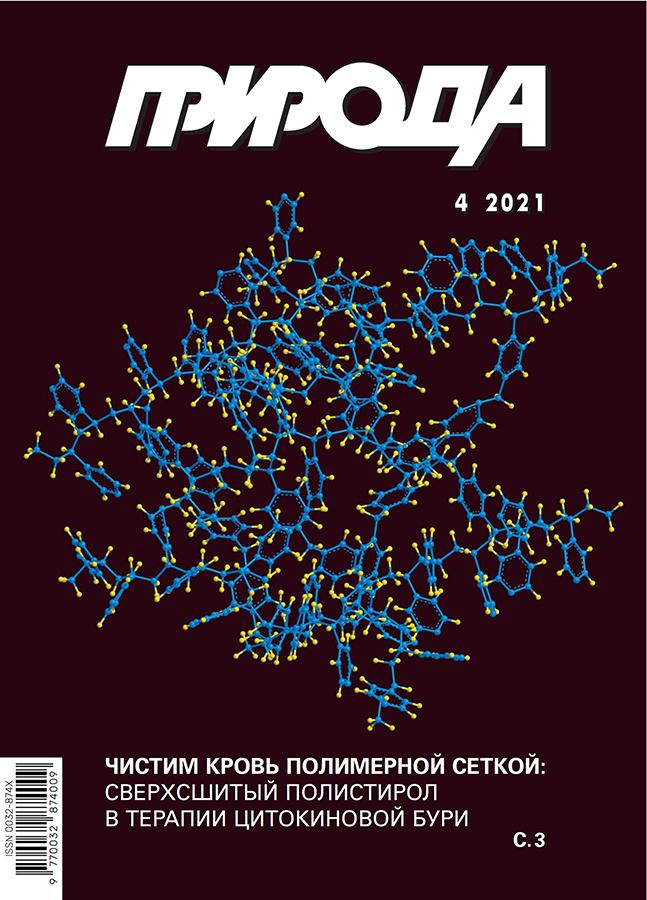To Clean the Blood with a Polymer Networks: Hypercrosslinked Polystyrene in Cytokine Storm Therapy
- Authors: Davankov V.A1, Tsyurupa M.P1, Pavlova L.A1, Pastukhov A.V1
-
Affiliations:
- Nesmeyanov Institute of Organoelement Compounds, RAS
- Issue: No 4 (2021)
- Pages: 3-11
- Section: Articles
- URL: https://journals.eco-vector.com/0032-874X/article/view/627975
- DOI: https://doi.org/10.7868/S0032874X21040013
- ID: 627975
Cite item
Abstract
More than half a century ago, we synthesized a polymer with contradictory properties in terms of polymer chemistry, i.e. hypercrosslinked polystyrene. Despite the rigid connection between each chain link with the links of neighboring chains, it turned out to be quite flexible, absorbs large amounts of any liquid, and noticeably increases in size. Currently the production of hypercrosslinked polystyrene sorbents amounts in thousands of tons per year; they are used widely in science and technology. An amazing property of the rigid polymer networks is its complete inertness in relation to blood cells and large protein molecules. This made it possible to create universal hemosorbents based on hypercrosslinked polymers, which have already saved hundreds of patients with general blood poisoning (sepsis). The article describes the stages of creation of these sorbents, which turned out to be so claimed during the current coronavirus pandemic.
About the authors
V. A Davankov
Nesmeyanov Institute of Organoelement Compounds, RAS
Email: davank@ineos.ac.ru
Moscow, Russia
M. P Tsyurupa
Nesmeyanov Institute of Organoelement Compounds, RASMoscow, Russia
L. A Pavlova
Nesmeyanov Institute of Organoelement Compounds, RASMoscow, Russia
A. V Pastukhov
Nesmeyanov Institute of Organoelement Compounds, RASMoscow, Russia
References
- Даванков В.А., Цюрупа М.П., Пастухов А.В. и др. Сверхсшитый полистирол: Чужой среди своих. Российская наука. Выстоять и возродиться. М., 1997; 182–187.
- Tsyurupa M.P., Davankov V.A. Hypercrosslinked polymers: basic principle of preparing the new class of polymeric materials. Reactive & Functional Polymers. 2002; 53(2–3): 193–203. doi: 10.1016/S1381-5148(02)00173-6.
- Цюрупа М.П., Блинникова З.К., Павлова Л.А. и др. Сверхсшитому полистиролу полвека: от нетривиальной идеи до промышленной реализации. Лаборатория и производство. 2020; 11(1): 86–96. doi: 10.32757/2619-0923.2020.1.11.86.96.
- Beth M., Unger K.K., Tsyurupa M.P., Davankov V.A. Microporous hypercrosslinked polystyrene as a restricted access packing in sample clean-up for high performance liquid chromatography. Part I: Evaluation of restricted access property. Chromatographia. 1993; 36: 351–355. doi: 10.1007/BF02263890.
- Winchester J.F., Ronco C., Brady J.A. et al. The next step from high-flux dialysis: application of sorbent technology. Blood Purif. 2002; 20: 81–86. doi: 10.1159/000046989.
- Brady J.A., Winchester J.F., Davankov V.A., Tsvurupa M.P., Pavlova L.A., Norris F.M., Quartararo P.J., Salsberg J.A. Methods for reducing levels of pro-inflammatory or anti-inflammatory stimulators or mediators in the blood. Patent USA 8,349,550; 2013.
- Елизаров Д.П., Елькин А.И., Даванков В.А. и др. Изучение сорбционной активности адсорбентов в эксперименте. Токсикологический вестник. 2003; 2: 18–21.
- Anisimova N.Yu., Dolzhikova Yu.I., Davankov V.A. et al. Prospects for the application of biporous sorbents based on hypercrosslinked styrene polymers for the prevention and treatment of systemic purulent-septic complications. Nanotechnol. Russia. 2012; 7(5–6): 318–326. doi: 10.1134/S1995078012030020
- Davankov V.A., Tsyurupa M.P., Pavlova L.A. Chapter 4: Detoxification of Blood and Plasma by Means of Hypercrosslinked Polymeric Hemosorbents. Immunopathogenesis of Sepsis and Use of the Hemosorption for Treatment of Cancer Patients with Sepsis. N.Yu.Anisimova (ed.). N.Y. (USA), 2014; 57–113.
- Магомедов М.А., Ким Т.Г., Масолитин С.В. et al. Использование сорбента на основе сверхсшитого стирол-дивинилбензольного сополимера с иммобилизованным ЛПС-селективным лигандом при гемоперфузии для лечения пациентов с септическим шоком. Общая реаниматология. 2020; 16(6): 31–53.
- Даванков В.А. Искусственная почка. Патент РФ 2 068 707 (1996).
Supplementary files









